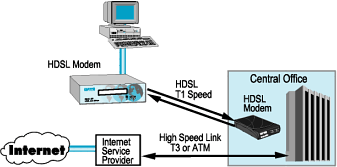
There has been a tremendous growth in the number of Small and Home
Offices (SOHOs). These may be individuals running businesses from their
home. They may also be individuals who work for large companies.
However, for one reason or another they are working at offices in their
homes. In either case the SOHO user often needs connection to some
corporate network that may be located some distance away. For this the
individual usually makes a selection from the plethora of Wide Area
Networking (WAN) services available. These extend from the economic but
low speed modem with dial up telephone network to the 'pricey' high
speed leased lines.
A popular offering which the SOHO user is selecting is the High-bit-rate
Digital Subscriber Line (HDSL). This TELCO offering allows the user
connection at T1 speeds, that is 1.544 MBPS, over several miles using
the ordinary UTP local loop coming into his/her facility. Outside the
United States these speeds are at E1, 2.048 MBPS. HDSL accomplishes this
by employing sophisticated modulation/demodulation techniques with
advanced equalization and echo canceling signal processing. While the
exact cost is dependent upon geographic location, it is much, much lower
than a leased T1 line.
This same HDSL service is also a convenient way to get high speed
communications between a user and an Internet Service Provider (ISP) and
thereby avoid one of the bottlenecks of the Information Highway.
The Model 681/682 HDSL modem provides the needed signaling for HDSL
service and at a convenient price. The Model 681 is for T1 rates and the
Model 682 is for E1 rates. The Model 681/682 realizes full T1/E1
signaling, full duplex, at local loop lengths of up to 12,000 feet. This
is typically the distance between an end-user location and a TELCO
Central Office. The unit realizes the HDSL signaling by employing 2
twisted pair cable connections.
Besides serving the applications described above HDSL signaling
(realized by a pair of HDSL) modems is a convenient way to tie 2 campus
LANS together. With HDSL you are able to transfer data between the LANS,
full duplex, at the high T1/E1 data transmission speed.
The illustration shows how the Model 681/682 can meet that demand for
Internet access at high speed. A Model 681 is stationed at a SOHO. A PC
is connected to the Model 681. Connection is desired to the end-user's
ISP through a TELCO Central Office, as shown. Data is sent from the PC's
Model 681 to a Model 681 at the Central Office. The data is then
multiplexed with traffic from other customers of the ISP using a device
called a Digital Subscriber Link Access Multiplexer (DSLAM) which is not
shown in the illustration. The multiplexed traffic is then placed on a
very high speed link, T3 for example, to the ISP. The ISP then sends it
out to the Internet. The Model 681 can also handle traffic coming the
other way. It can take signals off of the HDSL link from the Central
Office.
|

